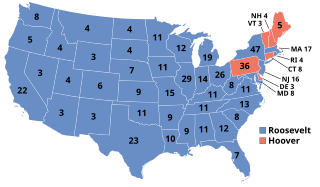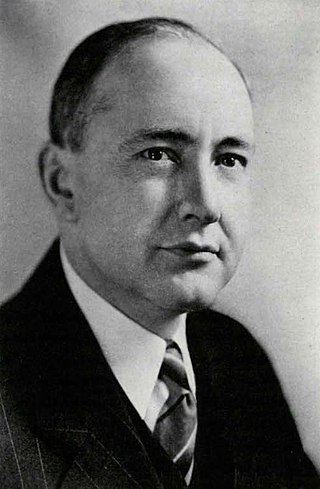
Presidential elections were held in the United States on November 8, 1932. Against the backdrop of the Great Depression, incumbent Republican President Herbert Hoover was defeated in a landslide by Democrat Franklin D. Roosevelt, the governor of New York and the vice presidential nominee of the 1920 presidential election. Roosevelt was the first Democrat in 80 years to simultaneously win an outright majority of the electoral college and popular vote, a feat last accomplished by Franklin Pierce in 1852, as well as the first Democrat in 56 years to win a majority of the popular vote, which was last achieved by Samuel J. Tilden in 1876. Roosevelt was the last sitting governor to be elected president until Bill Clinton in 1992. Hoover became the first incumbent president to lose an election to another term since William Howard Taft in 1912, the last to do so until Gerald Ford lost 44 years later, and the last elected incumbent president to do so until Jimmy Carter lost 48 years later. The election marked the effective end of the Fourth Party System, which had been dominated by Republicans. It was the first time since 1916 that a Democrat was elected president.

Presidential elections were held in the United States on November 3, 1936. In the midst of the Great Depression, incumbent Democratic President Franklin D. Roosevelt defeated Republican governor Alf Landon of Kansas in a landslide victory. Roosevelt won the highest share of the popular vote (60.8%) and the electoral vote since the largely uncontested 1820 election. The sweeping victory consolidated the New Deal Coalition in control of the Fifth Party System.

Presidential elections were held in the United States on November 7, 1944, during World War II. Incumbent Democratic President Franklin D. Roosevelt defeated Republican Thomas E. Dewey to win an unprecedented fourth term. It was also the fifth presidential election in which both major party candidates were registered in the same home state; the others have been in 1860, 1904, 1920, 1940, and 2016.

Presidential elections were held in the United States on November 2, 1948. Incumbent Democratic President Harry S. Truman defeated heavily favored Republican New York Governor Thomas E. Dewey, and third-party candidates, becoming the third president to succeed to the presidency upon his predecessor's death and be elected to a full term. It was one of the greatest election upsets in American history.

Sheridan Downey was an American lawyer and a Democratic politician from Wyoming and California. In 1934, he ran for lieutenant governor of California as Upton Sinclair's running mate in the "End Poverty in California" campaign. In 1938 he was elected U.S. Senator from California, and he served from 1939 to 1950.

The 1938 United States Senate elections occurred in the middle of Franklin D. Roosevelt's second term. The 32 seats of Class 3 were contested in regular elections, and special elections were held to fill vacancies. The Republicans gained eight seats from the Democrats, though this occurred after multiple Democratic gains since the 1932 election, leading to the Democrats retaining a commanding lead over the Republicans with more than two-thirds of the legislative chamber.

The 1938 United States House of Representatives elections was an election for the United States House of Representatives were elections for the United States House of Representatives to elect members to serve in the 76th United States Congress. They were held for the most part on November 8, 1938, while Maine held theirs on September 12. They occurred in the middle of President Franklin D. Roosevelt's second term. Roosevelt's Democratic Party lost a net of 72 seats to the Republican Party, who also picked up seats from minor Progressive and Farmer–Labor Parties.

Charles Arthur Sprague was the 22nd Governor of the US state of Oregon from 1939 to 1943. He was also the editor and publisher of the Oregon Statesman from 1929 to 1969. Sprague High School in Salem, Oregon is named after him.

The 1912–13 United States Senate elections were held on various dates in various states. They were the last U.S. Senate elections before the ratification of the Seventeenth Amendment in 1913, establishing direct elections for all Senate seats. Senators had been primarily chosen by state legislatures. Senators were elected over a wide range of time throughout 1912 and 1913, and a seat may have been filled months late or remained vacant due to legislative deadlock. Some states elected their senators directly even before passage of Seventeenth Amendment. Oregon pioneered direct election and experimented with different measures over several years until it succeeded in 1907. Soon after, Nebraska followed suit and laid the foundation for other states to adopt measures reflecting the people's will. By 1912, as many as 29 states elected senators either as nominees of their party's primary or in conjunction with a general election.

The Democratic Party of Oregon is the Oregon affiliate of the Democratic Party. The State Central Committee, made up of two delegates elected from each of Oregon's 36 counties and one additional delegate for every 15,000 registered Democrats, is the main authoritative body of the party. The party has 17 special group caucuses which also each have representation on the State Central Committee.

The 1936 United States Senate election in Massachusetts was held on November 3. Incumbent Democratic Senator Marcus A. Coolidge declined to stand for re-election. Republican Henry Cabot Lodge Jr. won the race to succeed him over Democratic Boston mayor James Michael Curley and former Suffolk County prosecutor Thomas C. O'Brien.

From March 12 to May 17, 1940, voters of the Republican Party chose delegates to nominate a candidate for president at the 1940 Republican National Convention. The nominee was selected at the convention in Philadelphia, Pennsylvania from June 24–28, 1940.

Monroe Mark Sweetland was an American politician in the state of Oregon. A native of the state, he served in both houses of the Oregon Legislative Assembly starting in 1953 for a total of ten years. A Democrat, he also twice ran and lost bids to serve as the Oregon Secretary of State and was a Democratic National Committeeman. Sweetland later served on the staff of the National Education Association, supporting passage of the Bilingual Education Act of 1968.
Since the Great Depression, Rhode Island politics have been dominated by the Rhode Island Democratic Party, and the state is considered part of the Democrats' "Blue Wall." Democrats have won all but four presidential elections since 1928, with the exceptions being 1952, 1956, 1972, and 1984. The Rhode Island Republican Party, although virtually non-existent in the Rhode Island General Assembly, has remained competitive in gubernatorial elections, having won one as recently as 2006. Until 2014, Democrats had not won a gubernatorial election in the state since 1992, and it was not until 2018 that they won one by double digits. The Rhode Island General Assembly has continuously been under Democratic control since 1959.

The 1942 Oregon gubernatorial election took place on November 3, 1942 to elect the governor of the U.S. state of Oregon. Republican candidate and Oregon Secretary of State Earl W. Snell defeated state senator Lew Wallace by a more than 3–1 margin, which remains the largest margin of victory for any candidate for Oregon governor.

The 1914 United States Senate election in New York was held on November 3. Incumbent Republican Senator Elihu Root chose not to seek re-election. James Wolcott Wadsworth Jr. was elected to a succeed Root, defeating Democrat James Watson Gerard.

The 1938 United States Senate election in Maryland was held on November 8, 1938. Incumbent Democratic U.S. Senator Millard Tydings was re-elected to a third term in office, easily defeating Republican Oscar Leser.

The 1938 United States Senate election in Georgia took place on November 8, 1938. Incumbent Democratic U.S. Senator Walter F. George was re-elected to a third term in office, holding off a primary challenge from Eugene Talmadge and Lawrence Camp. At this time, Georgia was a one-party state. George's victory in the September 14 primary was tantamount to election, and he had only nominal opposition in the general election.

Henry Leroy Hess was an American lawyer and politician from Oregon.

The 2022 Oregon gubernatorial election took place on November 8, 2022, to elect the governor of Oregon. Incumbent Kate Brown took office when fellow Democrat John Kitzhaber resigned on February 18, 2015. She won the subsequent 2016 special election a full term in 2018. Due to term limits, she was unable to run again in 2022.





















